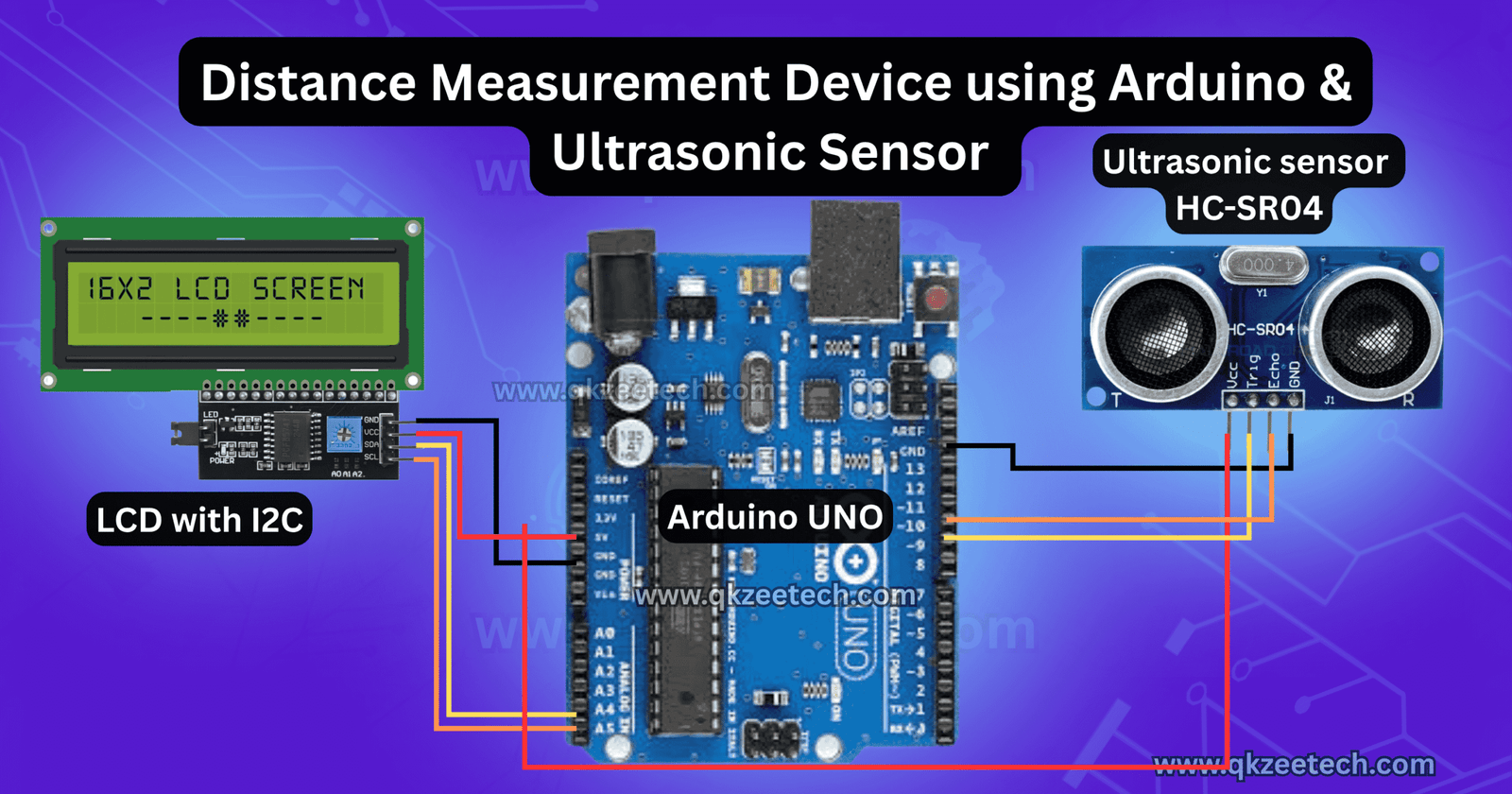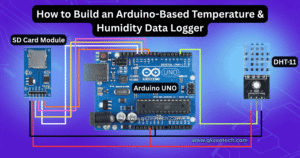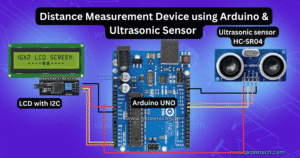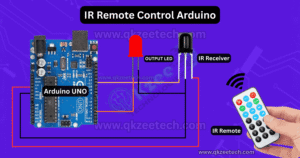Distance Measurement Device Using Arduino and Ultrasonic Sensor
Introduction – How Ultrasonic Sensors Work
Imagine you could “see” a wall or car using sound. Ultrasonic sensors do exactly that. In this Arduino ultrasonic sensor project, the HC-SR04 sends out high-frequency sound pulses and measures how long they take to bounce back. We then convert that into distance. This makes it a perfect topic for students projects, final year projects, and electronics engineering learning in Lahore, Pakistan.
Ultrasonic sensors find echoes of their own sound. The time difference between sending and receiving gives the distance. Because sound travels at a known speed, it’s a reliable method for distance measurement.
Components Needed – Arduino Uno, HC-SR04, Breadboard, Jumper Wires
To build this distance measurement Arduino device, you will need:
Arduino Uno – the microcontroller board that runs your code.
HC-SR04 Ultrasonic Sensor – emits and receives ultrasonic sound pulses.
Breadboard – to make connections without soldering.
Jumper Wires – male-to-male wires for flexible connections.
Power Supply – via USB or external 5 V supply.
Optional extras – LCD display, buzzer, LED indicators.
In Lahore especially near Hall Road, the local electronics market is full of these parts. Shops such as QKZ Tech, QKZee Technologies, QKZ, or QKZee guided by Qasim Shahzad often assist students with best engineering services at fair prices. Many students from universities come searching for “projects near me” in that area.
Circuit Setup – Step-by-Step Wiring
Here’s how to wire the HC-SR04 with the Arduino Uno carefully:
| HC-SR04 Pin | Arduino Pin |
|---|---|
| VCC | 5V |
| GND | GND |
| TRIG | Digital Pin 9 |
| ECHO | Digital Pin 10 |
Step-by-Step Instructions
Place the Arduino Uno and the breadboard on your workspace.
Connect the VCC pin of HC-SR04 to the 5V pin on Arduino.
Connect the GND pin to Arduino’s GND.
Link the TRIG pin to Arduino digital pin 9.
Link the ECHO pin to Arduino digital pin 10.
Double-check the wiring—especially that VCC and GND are correct—before powering.
This wired setup ensures the HC-SR04 triggers a pulse and listens for its reflection. Mistakes in wiring often cause no reading or erratic distances.
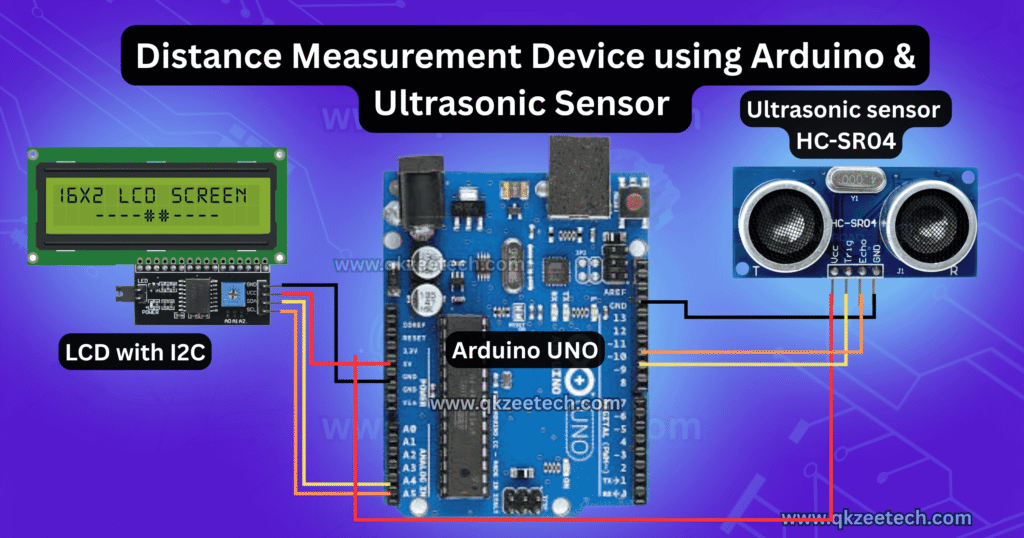
Arduino Code – Explanation of Distance Calculation Formula
Once the circuit is ready, it’s time for the software side. Here’s a sample sketch (program):
const int trigPin = 9;
const int echoPin = 10;
long duration;
int distance;
void setup() {
Serial.begin(9600);
pinMode(trigPin, OUTPUT);
pinMode(echoPin, INPUT);
}
void loop() {
digitalWrite(trigPin, LOW);
delayMicroseconds(2);
digitalWrite(trigPin, HIGH);
delayMicroseconds(10);
digitalWrite(trigPin, LOW);
duration = pulseIn(echoPin, HIGH);
distance = duration * 0.034 / 2;
Serial.print("Distance: ");
Serial.print(distance);
Serial.println(" cm");
delay(500);
}
Distance Calculation Explained
pulseIn(echoPin, HIGH)returns the time in microseconds for the echo to return.Sound travels at ~343 m/s, which is ~0.034 cm/µs in air.
Since the echo travels to the object and back, you divide by 2.
So: distance = duration × 0.034 / 2 gives you centimeters.
This code is a foundation you can alter for IoT projects, Arduino sensor projects, or more complex systems.
Testing & Calibration – Ensuring Accurate Readings
After uploading the sketch, open the Serial Monitor in the Arduino IDE. You’ll begin seeing distance values in centimeters.
Move an object closer or further to test accuracy. If readings wobble:
Check all wires and connections.
Ensure no ambient noise interference.
Add small delay or smoothing code.
Perform calibration at known distances and compare.
Accurate calibration is especially crucial in automation, robotics, or safety-critical systems.
Applications – Parking Sensors, Obstacle Detection Robots
This distance measurement Arduino project is highly versatile. Some real-world applications:
Parking Sensors: Alerts when vehicles approach walls.
Obstacle Avoidance Robots: Let robots avoid collisions.
Industrial Automation: Use in CNC projects, robotic arms, or conveyor systems.
DIY Projects: Great for school projects, university projects, or science projects.
Smart IoT Systems: Combine with ESP32 or ESP8266, and send data to Firebase, Thingspeak IoT, or Blynk IoT.
You might even integrate Raspberry Pi projects or image processing to build advanced robotics or CNC automation systems.
Where to Access in Lahore & Price Insights
If you’re searching “student project in Lahore” or “best shop for students projects in Lahore Pakistan,” QKZee Technologies Hall Road is your stop. This electronics market is famed for plentiful electronics parts.
QKZ Tech and QKZee Technologies (under Qasim Shahzad) are well known for offering consultation for final year projects in Lahore. Students often get full kits and support from them. The best price for student projects often comes from these trusted places.
Typically, a simple Arduino ultrasonic sensor project might cost between PKR 2,500 and 4,000 in Lahore. More complex automation or IoT-based systems (with ESP8266, Raspberry Pi, etc.) push the price upward, depending on parts and software support.
Conclusion – Learning Outcomes
Building a Distance Measurement Device Using Arduino and Ultrasonic Sensor teaches you how sensors interface with microcontrollers, how to write and troubleshoot code, and how real-world physical systems behave. This project bridges theory and practice. It sets a strong foundation for advanced engineering projects, IoT solutions, automation, and robotics. In Lahore, many students turn to QKZ / QKZee / QKZ Tech and Qasim Shahzad for support with their final year projects. Whether you’re doing a school project, university project, or a full FYP in Pakistan, this Arduino project is a standout option that’s both educational and practical.
Where to Buy Your Electronics Components
Looking for affordable components for this Arduino project? Check out QKZee Technologies, an online shop in Lahore, Pakistan, offering the best components for students and DIY projects. Whether you’re looking for sensors, modules, or other electronics at a cheap price, they’ve got it all. Visit them at QKZeeTech.
What is the effective range of HC-SR04?
Between 2 cm and 400 cm, with better accuracy in mid-range distances.
Can I use ESP32 or ESP8266 instead of Arduino Uno?
Yes. Use them for IoT, sending live data to Firebase, Thingspeak IoT, or Blynk.
Where can I get consultation for final year projects in Lahore?
Visit Hall Road, and check QKZ, QKZ Tech, or QKZee Technologies, led by Qasim Shahzad.
What is the typical price for this project in Lahore?
Basic version: around PKR 2,000–5,000. Advanced versions (IoT, LCD, extra sensors): more.
Which students benefit most from this project?
Electrical engineering, electronics engineering, robotics, automation, and IoT students.
Where to buy Best Price Electronics components in Pakistan?
visit QKZee Technologies Hall Road Lahore, or contact QKZee Technologies for genuine parts and student-friendly prices,
Hall Road Electronics Market, or order from QKZ Tech and Qkzee Technologies for the best price.

